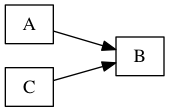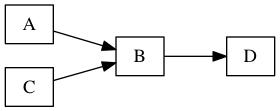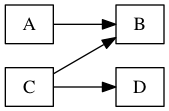Combining inference and support#
Now that we have both the inf and sup keyword categories, we have to understand how they work together.
As a first example, try putting so and by together:
A, so B, by C.

Pop Quiz#
What graph do you suppose is produced by the following Meson script?
A so B by C therefore D
It’s clear that there will be three arrows:
sodraws an arrow fromAtoBbydraws an arrow fromCtoBthereforedraws an arrow that terminates atD
But where will the arrow terminating at D begin? From B or from C?
In other words, what are we saying D follows from?
Answer:
RIGHT |
WRONG |
|
|
The Meson script is saying that D follows from B, not from C.
Conceptually, we might say that Meson is somewhat biased toward a “forward flow” of deduction, in the sense that “by” or support statements should be thought of as nested parenthetically within an overall “so” or inference flow.
Thus, A so B gets us an arrow from A to B, then the by C
parenthetically nudges in an arrow from C to B, and then we resume the
overall forward flow with an arrow from B to D. To be precise:
An inf keyword always draws a deduction arrow from the most recently inferred node (like
Bin this example), NOT from any nodes that may have been mentioned in support (likeCin this example).
Recap#
Using just the language features we have considered so far, we can already build up a fairly complex graph:
A, so B, therefore C by D and E. Hence F, using G, so H.

Remember, the punctuation and word variation are just there to make the script more pleasant for a human being, and the very same graph could have been produced by a simpler but more monotonous sounding script:
A so B so C by D and E so F by G so H
This is noted in order to demonstrate how simple the Meson language actually is, but please, don’t write scripts like this!

